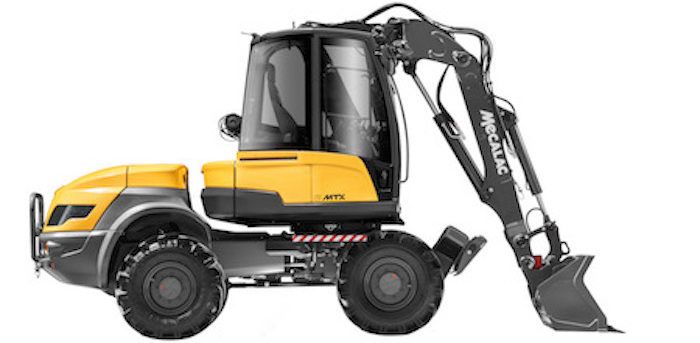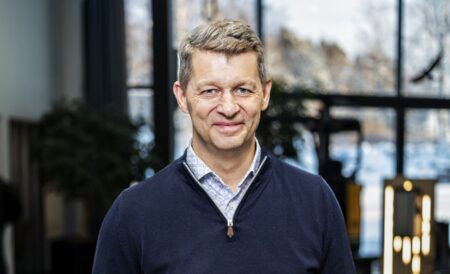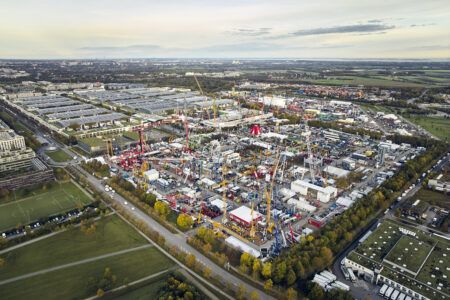Efficacité, compacité, autonomie. This is the no-compromise formula for electrification at Groupe Mecalac, which has a philosophy sharply focused on building innovative, process oriented machines for space-limited and environmentally sensitive urban sites.
The French company has established an enviable worldwide reputation for eye-catching vehicles, boldly reimagining accepted configurations to create new forms of compact multifunctionality.
Mecalac recently acquired the Terex production plant in Coventry, UK, and is on the cusp of an ambitious expansion beyond its traditional European markets and into the USA, where it sees a burgeoning demand for its versatile and space-efficient off-highway products. Now Mecalac is staking a claim in the emissions-free markets of tomorrow by unveiling the e12 – a market-ready, fully electric excavator.
Making its world debut on home soil at Intermat Paris 2018 on April 23-28, it is poised to receive a Special Award for Energy Transition. Commercial availability is anticipated in early 2019. The machine is an electric version of the 12MTX, with which it shares dimensions, though sporting a blue, rather than yellow, livery. Identified as the perfect template for a new electric vehicle due to its strikingly innovative architecture, it is with the 12MTX that the e12’s story begins.
Billed as the first articulated excavator in the world, the 12MTX’s rear-mounted 85kW Tier 4/Stage IV diesel engine is positioned separately from a compact turret that offers full 360° rotation. With an operating weight of 9,700kg (10.7 tons), an overall length of 4,619mm and a turning width of 2,710mm, its maximum reach is 7,100mm and its maximum break-out force 6,400daN.
Though an excavator, its uniquely versatile design enables it to do the work of a wheel loader, a telehandler and a tool carrier, so that fewer vehicles are needed on site and use is highly efficient.
Mecalac reckons that a 12MTX spends just 25% of an average day in idle mode, compared with 70% for conventional vehicles performing only one job.
“You have to imagine it’s four machines in one,” explains Mecalac’s head of design and product management, Patrick Brehmer. “We need a powerful engine to run the hydraulics – but a compact turret. It’s the most compact excavator in the world because the engine is separate from the turret. Then you have an articulated undercarriage, so the boom is made to work in both directions. It is also a loader, but instead of driving forward and backward to load we can use the boom. We can do dynamic and static loading, even at a 90° angle. We can take pallets like a telehandler but we can place them 4m [13ft] below ground level, which no telehandler can do.”
In conventional excavators, the dipper cylinder is positioned over the boom, providing power in only one direction, but the 12MTX’s cylinder is underneath, providing real lifting power for loading and handling. Whereas an excavator normally has just one pump, needing only to sit and dig, a loader has two pumps, enabling simultaneous driving and lifting.
“The 12MTX has two completely separate hydraulic circuits: one hydrostatic closed loop for driving and one for working,” says Brehmer. “The boom has no influence on driving. Normally, when you begin to move an excavator’s turrets and boom, you slow down – but we need maximum energy in both for loading and tool carrying. The hydrostatic loop’s high sensitivity is important for telehandling, where you must go inch-by-inch.”
With cities such as Paris pushing to eliminate diesel vehicles, emissions-free construction zones are on the horizon and huge global markets for electric machines may rapidly emerge. Thus Mecalac looked into the key obstacles to commercially viable electric excavators.
First, any compromise on performance must be avoided; customers need to do the same job in the same time as with diesel. Second, for urban applications there must be no compromise on compactness. Finally, there can be no compromise on autonomy – the length of a working cycle. This is the greatest challenge presently facing electric vehicle manufacturers.
“One day of work is 8-10 hours,” says Brehmer, “Our customers are under day-to-day pressure and cannot just work for 4-5 hours. Unlike a classical excavator, in our vision the vehicle is constantly working, not waiting for the loader or the telehandler. So there must be no compromise on performance, compactness or autonomy.”
For eight hours of autonomy in continuous, peak-performance operation, Mecalac calculated that a mobile excavator would require 146kWh of energy, necessitating 1m3 of batteries.
But can this be accommodated without compromising that second non-negotiable –compactness?
The answer lay in the architecture of the articulated 12MTX.
“Initially, it was designed to carry a big engine and keep a compact turret, but we realized that it was perfectly ready for electric. We could replace the engine with 1m3 of battery and remain completely compact,” explains Brehmer. “Other architectures involved some form of compromise, but we didn’t want to add one millimeter to the 12MTX because then the customer would lose something. Even with new engine specifications like Tier 4 or 5, we make each machine smaller than the last – because the job doesn’t change and the operator still needs optimum visibility.”
Even keeping the e12’s batteries to 1m3 required a technology with much higher power density than the lead-acid batteries used in cars and forklifts, which would only provide around 30kWh per 1m3 of space. While offering superior power density, lithium-ion batteries presented limitations in terms of lifetime.
“You see it with smartphone batteries,” Brehmer explains. “Lithium-ion batteries are made for 1,000 charging cycles, which means three years. After that, battery performance quickly decreases and you can no longer work for a full day. But our machines are made for nine years. It’s okay for a phone, but not a machine.”
Instead, Mecalac opted for lithium iron phosphate (LiFePO4 or LFP) battery technology, which offered several advantages. LFP has sufficient power density to provide the requisite 146kWh from a 1m3 space and can also complete three times as many charging cycles as lithium-ion without deterioration –supporting peak vehicle performance across a nine-year lifespan.
Moreover LFP batteries are dry and inert, which eliminates any risk of leakage or explosion, even in the event of a severe shock on the work site – and any possibility of a 1m3 excavator battery-pack combusting is clearly better avoided. LFP batteries require no specific cooling within the temperature and power ranges of e12 operation, saving on space and cost. But even with LFP in place, further innovation was still required to achieve eight-hour autonomy at 100% performance.
“We had to keep optimizing the energy request,” Brehmer continues. “That’s why the whole pilot system, from the joystick to the main valve, is now electrohydraulic – with a new generation of main valve that allows us to gain the last 15% by optimizing the power curve.”
The benefits of eliminating the noise, vibration, emissions and maintenance of internal combustion are clear. An electric powertrain also brings performance benefits, including the increased precision of dedicated closed circuits.
The e12 recovers energy during braking and can feed it back to the batteries via an inverter. But what excites Patrick Brehmer most is the instantaneous response that electric transmission affords.
“Electric motors have great tractive force and, unlike a classical engine, which achieves maximum torque only at a certain RPM, we have maximum tractive effort immediately available. For off-highway and loading applications it’s incredible!”
He expects the e12 to be ready for market in 2019. “We didn’t want to just make a prototype or concept. At every show you see electric and autonomous vehicles, but what can customers actually buy? Quite a boring machine. But at Mecalac, innovation only has a meaning if we bring it to the customer.”
Diesel engines entail a range of solutions around differing Tiers, Stages and diesel quality between countries – but electric power, Brehmer believes, will provide a single, whole-world solution.
The date of diesel bans in some European cities is already fixed and feedback suggests that the e12 will attract interest on both sides of the Atlantic. Change is in the air and, with its transformative brand of thinking, Mecalac could be happily placed to lead a French revolution in global construction vehicle markets.





